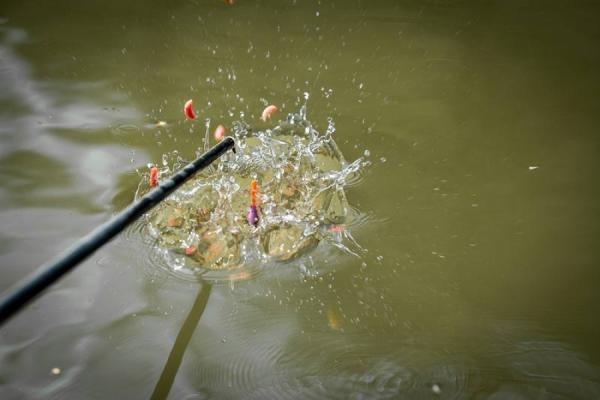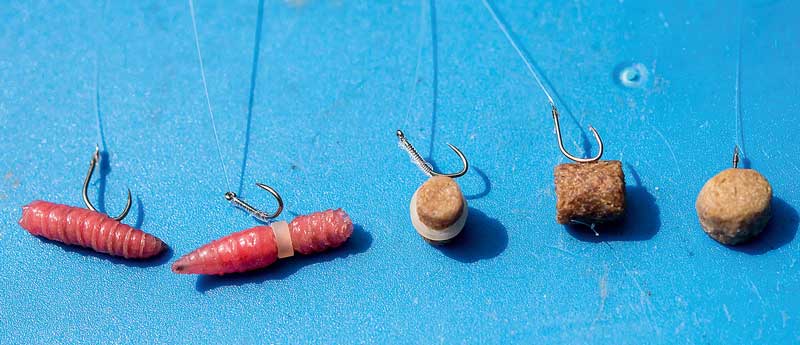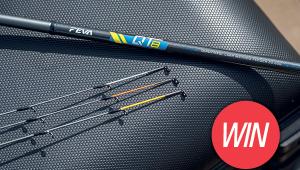Shallow Secrets

Shallow fishing is the topic for commercial god Jamie Hughes this month. This is his not-to-be missed guide…
If you were to ask anglers what their favourite method was during the summer months, you could be almost certain that the majority would answer with “fishing shallow”. There are few things more exciting than a shoal of fish swirling for your loose feed, or your elastic being pulled out as soon as the rig hits the water.
Over the years there have been plenty of articles written on this subject, but as it’s something I have never written in depth about myself I felt I would always prefer to fish shallow ‘properly’ using a correctly shotted float. Jigga rigs and other bolt rigs are massively popular these days, but I still believe that in most situations a correctly shotted rig will outscore these methods, allowing anglers to understand more clearly how the fish in the peg are responding.

Jamie likes to fish shallow with a correctly shotted rig, and isn’t an advocate of ‘Jiggas’ or bolt rigs.
Of course, there are literally hundreds of different shallow fishing situations, from mugging, slapping 8mm pellets or even fishing paste shallow. What I would like to focus on with this piece, though, is fishing shallow for mixed species. This is a method that is massively popular at fisheries in the northwest, where fish such as ide, crucians, F1s, roach and small carp are the target.
As is the case with most methods, shallow fishing has had to evolve over the years as fish become more cautious; the days of slapping pellets with any old rig have long gone, and now each detail has to be finely tuned to ensure minimal bites are missed. It is the small improvements such as feeding, accuracy, rigs and the correct kit in general that I would like to cover in depth, just to show how each change can make a difference.
For the session today I have came to my favourite Weston Pools fishery; this place has a massive stock of mixed species so is ideal for me to demonstrate a bit of short shallow fishing.
The ultimate aim in fishing shallow is to get the fish competing as much as possible in the upper layers of the peg; the higher the rate of competition the less each fish will inspect the hook bait, meaning more positive bites and more fish in the net. While that sounds pretty simple, there are still plenty of little things that can be done, to ensure less bites are missed, more time is spent fishing and ultimately more fish end up in the net.
Firstly I’d like to talk about feeding: this of course is the single most important factor when fishing shallow. For me a loose feed such as maggots or casters is my first choice, as both of these baits can be fed regularly by either hand or catapult. My decision of exactly which bait to choose depends on several factors: firstly the weather, as casters are far easier to feed accurately in any wind; secondly the species of fish I am expecting to catch, as ide and F1s generally prefer a maggot due to its slower fall through the water, and lastly the noise factor – casters make a much louder splash when they are fed, which can make all the difference when those around you are feeding maggots.

Feeding slop can help hold fish in the swim.
Jamie likes a dibber for 12 inches deep or less…
… and a bristled float for any deeper than 12-inches.
As I mentioned, these baits both have a relatively slow sink rate, which makes them ideal for attracting fish into the upper layers. How they are fed into the swim, though, is what will determine how well you actually catch. Of course, little and often is generally the way to go to get the fish feeding but the timing between your feeds can determine exactly at what depth the fish settle.
To begin with I like to feed my bait at 15 to 20 second intervals; my thinking behind this is that as a maggot sinks at around five seconds per foot, by feeding every 15 seconds there is only ever one lot of loose feed falling through the top three feet of water. I will then increase or decrease the regularity of my loose feed depending on what depth I am catching at.
The accuracy of my loose feed is also something I have also found to be massively important! We are all guilty of settling for feed landing ‘close enough’ to our pole tip, but when you think about it, the tighter you can group your loose feed around your float, the smaller the area the fish have to feed in.
This means that multiple fish have to fit into a smaller area, which creates greater competition and more bites! I have spent A LOT of time practising my feeding and now class this as my biggest edge when fishing shallow.
Although maggots and casters are always my first choices, there are some days when an additional cloud in the water is needed to get the fish up and competing; this generally happens in really hot weather or towards the end of the summer, when they have been caught a few times already.

The various hook baits and presentation modes that Jamie uses.
If this is required then either a sloppy groundbait or a chopped worm/soil mix is best. What is important, though, is that plenty of particles are still fed with the mixes to prevent the fish from gill feeding and ignoring the hook bait.
My rigs for catching mixed species shallow are very similar to those I used back on the canals years ago for fishing casters – a 0.1g bristled float for depths from three feet to 12 inches and a small inline dibber for less than 12 inches. I prefer a bristle when fish are feeding deeper and more cautiously, as it offers less resistance and swap to a dibber when they are feeding really shallow and bites are confident.
The most important element to each rig is that a maximum of four inches of line is used between the float and pole tip; any more than this will result in missed bites.
Each rig consists of 0.15mm main line and is shotted with five No11 shot spread though the rig to begin with, a 3in 0.10mm hooklength to allow a bulk to be placed close to the hook if required and the rig is finished with a size18 Kamasan B911 with a hair-rigged band. Banding a maggot allows the bait to fall horizontally and prolong the fall. Also multiple fish can be caught on the same hook bait.
It may come as a surprise to most that when intending to catch the bulk of my fish shallow I will set up four to six rigs, which will pretty much be identical other than the depth. The reason behind this is because I have to have different rigs set at 6in intervals, which allow me to keep in contact with the feeding fish, but I have to maintain the short line between my float and pole. Deciding on which rig to use at what time is pretty simple: if I am missing bites with a rig then I swap to a shallower one, and of course if I’m not getting bites I move deeper!
The key factor is changing between rigs as quickly as possible in order to keep quiet spells to a minimum; just by reacting to a depth change a couple minutes faster, a massive edge can be gained on other anglers as you are putting a couple of extra fish in the net with each rig change. If this is done up to 20 times over the course of a match then your catch rate can increase massively.
While bait, feeding and rigs are of course the main factors for shallow fishing there is one item of kit that I feel I could not be without as it dramatically improves my efficiency.
Shallow or short top kits have been around for ages but I still see very few when out on the bank. These kits have three advantages over conventional top kits: firstly, because of the reduced length a smaller length of elastic is used, which means that even when using soft hollows fish can move quietly out the peg once hooked but still be landed quickly as the short length of elastic powers up faster; secondly, and again because of the length, each fish hooked will surface extremely close to the angler making netting fast and easy. Lastly the tops WILL stiffen your pole, meaning a quicker response and less missed bites!

One of the most important parts of shallow fishing is covering your options with depths, and being willing to regularly change when required.
Today’s quick session highlights perfectly the need for short lines and multiple rigs. Starting on my 3ft rig, I am quickly catching small crucians by feeding 10 maggots every 15 seconds. After half an hour I’m missing every other bite, so a quick try with an 18in rig produces several decent F1s, and upping my feed to 10 maggots every 10 seconds sees me catch here for a good 15 minutes without missing bites, then slowly the bites begin to fade and a drop in feeding and a swap back deeper puts me back among the smaller fish.
This same pattern continues throughout the two-hour session and I am forced to swap rigs and feeding around 12 times in this short space of time. Don’t get me wrong, I could have easily sat with the same rig in my hand and caught fish in spells, but by continually swapping around and keeping in touch with what is happening in my peg, I end up with no quiet spells and a much bigger weight at the end of the session!

Would you set up six different rigs for fishing a single shallow swim?
Like what you see?
Or buy a single issue
- Log in or register to post comments









